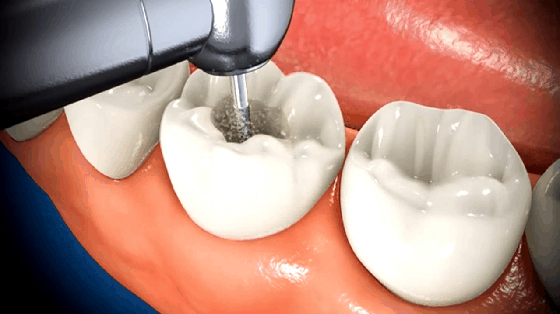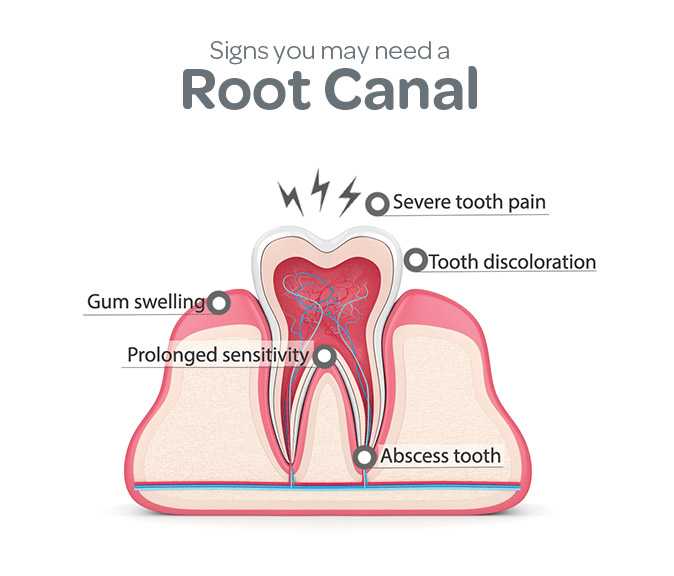Root Canal Treatment
Root Canal treatment/ RCT is done when the root area of the tooth gets decayed due to extensive bacteria development. The dental expert will remove all the pulp area which gets infected and put the necessary suitable material in the area. The material will be biodegradable that can properly suit the dental area. It is possible to retain the tooth with RCT.

Talk to a Dentist Now!
What is RCT or Root Canal Treatment?
Whenever we think of a dentist, the first things that come to mind are ‘toothache’ and ‘root canals’. Whenever there is an extensive development of the bacteria, the chances of decaying increase. In several cases, the decay of the tooth reaches the root of the teeth, which infects the pulp area.
This kind of situation is accompanied by pain and can decay the whole tooth and might need to remove the tooth. So a proper tooth root canal treatment is the better way to treat the decay and save the tooth from damaging further. A large majority of people fear RCT as they believe it is a painful procedure.

But, how many of us know and understand what a root canal is how, and why a RCT is performed?
RCT is a multi-step procedure that involves:
- Removal of the infected and inflamed pulp
- Cleaning the root canals and disinfecting them
- Filling the canals with an inert material and sealing them
- A post-root canal crown or cap
When Do You Need a Teeth Root Canal Treatment?
Now that we know why a root canal procedure is done, the next question that comes to mind is when do you need one? Are there any signs and symptoms that indicate one may require an RCT?

Yes, some common situations demand an RCT and these are:
- Teeth with deep decay
- Broken or cracked teeth
- Teeth with gum diseases
- Failed dental fillings
- Teeth that have suffered trauma
Symptoms that most people are likely to experience that may indicate the need for an RCT:
- Toothache: This is one of the first reasons why you would visit a dentist and the pain can range from mild to severe. The Toothache can increase on changing position, especially while lying down or biting onto something using that particular tooth.
- Sensitivity: In normal cases, the enamel layer covers the inner two layers and we, therefore, do not experience any sensitivity. However, when the dentin and pulp layers are exposed, you might experience increased sensitivity to air, hot foods, sour foods, and sweet foods.
- In many cases, the tooth pain might be mild and most patients tend to ignore it. However, even though the pain subsides, the infection can still spread to tissues around the decayed tooth, resulting in swelling.
A large number of patients who report to the dentist with swelling are treated by root canal procedures.
Expert's Opinion
- Dr. Zita Antao Dental Director of Sabka Dentist says “Root canal helps the tooth look and perform normally. Many patients hesitate to take treatment. But if you don’t get the RCT the tooth eventually falls out.”
- Dr. Jena Shah BDS, Dental Director for Audit and Compliance at Sabka Dentist says “Root canal saves your tooth structure and a crown will strengthen the structure.”
- Dr. Manan Dhulia Dental Director of Sabka Dentist advises “keeping the teeth clean as the large cavity damages the tooth structure.”
Frequently Asked Questions
What should you know about pulp and RCT?
One must first understand the anatomy of a tooth to understand RCT. The outer enamel layer encloses a hard layer called dentin and soft tissue pulp. Pulp is the soft tissue that contains blood vessels and nerves. Pulp is housed within the pulp chamber and root canals of a tooth. In RCT, the pulp along with its nerve supply is removed.
However, a tooth’s nerve is not vitally important to a tooth’s health and function as its only function is sensory i.e. to provide the sensation of heat or cold. The presence or absence of a nerve will not affect the day-to-day functioning of the tooth. However, after treatment, the tooth is less viable and thus more susceptible to fracture.
Is a tooth dead after this treatment?
Since the pulp is removed, the tooth becomes non-vital/dead after RCT.
What happens during RCT?
- Anesthesia: The dentist starts by administering local anesthesia to numb the affected tooth.
- Isolation: After that, the dentist might isolate this tooth with a rubber dam or cotton rolls to keep it clean and dry during the procedure.
- Access Opening: A dental handpiece will then be used to gain access to the inside of the tooth ( pulp chamber). The root canals will be located and the working length will be determined with the help of 8 or 10 endodontic K – files.
- Biochemical Preparation and Irrigation: A series of files are used to clear the pulp debris and shape the canals. Along with it, irrigation will be done to wash away any remaining pulp. An antimicrobial solution is also used to kill any remaining bacteria and reduce the risk of further infection.
- Obturation: The canals are then filled and sealed with a rubber-like biocompatible material called gutta-percha. The opening in the tooth may be closed with a filling, while you wait for the permanent crown.
- Capping: After a week, the dentist will finish the treatment by placing a permanent crown or similar type of restoration.
What happens when you don’t get your carious tooth treated?
If you delay the recommended RCT, it will only worsen the tooth infection. Medications will only provide temporary relief. The periapical abscess can occur if the bacterial infection occurs in the soft dead pulp of the tooth.
Symptoms of a periapical abscess include pain, swelling (at the base of the tooth, gums, and/or cheek), and suppuration. If the infection becomes severe such that furcation gets involved, the only alternative then is extraction/removal of a tooth.
How to get rid of tooth pain?
Over-the-counter prescription analgesics, eugenol ingredients of cloves, and lukewarm salt water can help to alleviate pain. But, a visit to the dentist will help to identify and treat the cause of pain.
How painful is this treatment?
RCT pain is normal which is mild. But, it is temporary and RCT is meant to relieve the pain of decayed or traumatized teeth.
Can this treatment hurt years later?
In case of failure of RCT or dislodged crown restoration, re-infection can result in symptoms of pain and swelling.
Which is better – RCT or Extraction?
It is always better to save the natural tooth with RCT. Extracting and then replacing a tooth results in more treatment procedures that could even impact the neighboring teeth and the supporting gums.
What care should be taken after RCT?
One must maintain good oral hygiene practices after completion of RCT. An X-ray may be needed post-treatment to ensure that obturation treatment is done properly and all the signs of infection are absent. The tooth may feel sensitive for the first few days after the treatment, especially if there was pain or infection before the procedure.
There can be transient discomfort, which can be relieved with prescribed medications. The treated tooth can feel different from other teeth temporarily after the treatment. However, if severe pain or pressure manifests, visit the dentist. Also, what to eat after RCT. Consume soft food after root canal treatment.
Avoid hard or hot foods that might hurt your teeth. It is suggested to not eat for a few hours until the numbness in your mouth wears off so that you don’t bite your cheek or tongue. With good care and attention, a diseased tooth treated with RCT can last a lifetime!
How long does a root canal last with a crown?
As crowns protect the tooth from any damage, the possibility of a root canal lasting for a longer duration is high. Generally, a proper root canal can last for more than 12 years. However, it is equally important to avoid eating unnecessary hard food.
What is tooth root canal treatment?
In RCT dental treatment, the drilling is done in the decayed portion of the tooth to remove the infected pulp. The canals are then filled with the dental material called gutta-purcha and sealed from the dental material outside. After the root canal treatment, a dental cap is installed to protect the treatment from any damage.
What are the symptoms of failed RCT?
- Sensitivity to pressure/ Tenderness
- Swelling/ Abscess/Gum boil/Sinus Tract
- Root Canl Treatment pain
- Thermal sensitivity (to hot or cold stimulus)
Having above symptoms does not always indicate endodontic failure. Thus, a visit to the dentist can help to identify the cause of symptoms.
About Author

A confident Healthcare Professional with over 8 years’ experience successfully diagnoses & treats patients’ dental conditions. Skilled in Endodontics, Implantology, Healthcare, and Surgery, a confident communicator who can relate well to dental patients. Having a proven ability to ensure that dental practices in surgery are continuously updated to provide first-rate care to patients and their families.








